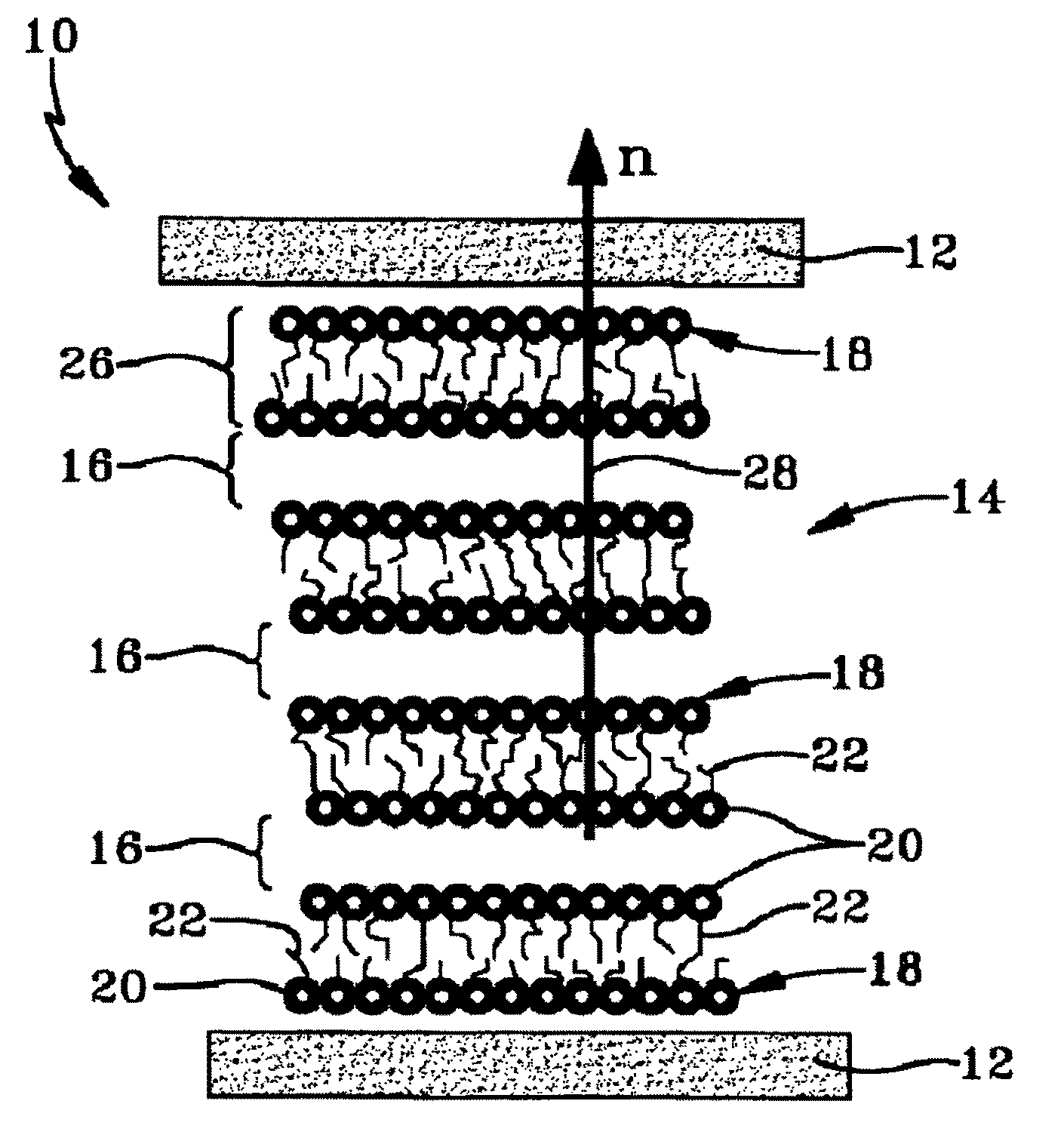Homeotropic and hybrid bulk alignment of lyotropic chromonic liquid crystals
a chromonic liquid crystal, hybrid technology, applied in the field of liquid crystal cells, can solve the problems of affecting the interaction between the liquid crystal and the ligand, lyotropic liquid crystals are more difficult to align than their thermotropic counterparts, and the method of alignment is well established for thermotropic liquid crystals,
- Summary
- Abstract
- Description
- Claims
- Application Information
AI Technical Summary
Problems solved by technology
Method used
Image
Examples
example 1
Homeotropic Bulk Alignment of the V20 LCLC by the Polymer LARC CP1 Coated from the Chloroform Solution
[0054]To make a cell of LCLC comprised water solution of V20 homeotropically bulk oriented, glass substrates were washed in an ultrasonic bath of Alconox detergent and water for 10 minutes at 60° C. The substrates were then removed and dried. The solution of LARC CP1 (developed by NASA [V. G. Nazarenko, A. K. St. Clair, R. Klouda, R. D. Polak, Yu. Nastishin and O. D. Lavrentovich, Journal of the SID, 135 (1998)]) in chloroform at a concentration of 0.5% was coated onto the glass substrates by a spincoater at 3000 rpm. The solvent was dried at 95° C. for 20 minutes. The cells then were made using the two substrates. The cell thickness was controlled by 15 μm spacers and fixed by epoxy glue applied along the spacer strips. The LCLC, comprised of a 7% water solution of V20, preheated to the isotropic phase, at temperature about 10° C. higher than the temperature of the phase transition...
example 2
Absence of a Homeotropic Bulk Alignment of the V20 LCLC by the Polymer LARC CP1 Coated from the Dimethelcetylamid Solution
[0055]To make a cell of LCLC comprised water solution of V20, glass substrates were washed in an ultrasonic bath of Alconox detergent and water for 10 minutes at 60° C. The substrates were then removed and dried. A 0.5% wt. solution of the chemically imidized polyimide LARC CP1 (developed by NASA) [25] in dimethylacetamide was spin-coated onto the glass at 3000 rpm. [V. G. Nazarenko, A. K. St. Clair, R. Klouda, R. D. Polak, Yu. Nastishin and O. D. Lavrentovich, Journal of the SID, 135 (1998)]). The cells then were made using the two substrates. The cell thickness was controlled by 15 μm spacers and fixed by epoxy glue applied along the spacer strips. The LCLC, comprised of a 7% water solution of V20, preheated to the isotropic phase, at temperature about 10° C. higher than the temperature of the phase transition to the isotropic phase (T≧40° C.), filled the cell ...
example 3
Absence of a the Homeotropic Bulk Alignment of the Cromolyn LCLC by the Polymer LARC CP1 Coated from the Chloroform Solution
[0056]To make a cell of LCLC comprised water solution of Cromolyn (C23H14O11Na2), glass substrates were washed in an ultrasonic bath of Alconox detergent and water for 10 minutes at 60° C. The substrates were then removed and dried. A 0.5% wt. solution of the chemically imidized polyimide LARC CP1 (developed by NASA) [V. G. Nazarenko, A. K. St. Clair, R. Klouda, R. D. Polak, Yu. Nastishin and O. D. Lavrentovich, Journal of the SID, 135 (1998)] in chloroform was spin-coated onto the glass at 3000 rpm. The cells were made using the two substrates. The cell thickness was controlled by 15 μm spacers and fixed by epoxy glue applied along the spacer strips. The LCLC, comprised of a 14% water solution of Cromolyn, preheated to the isotropic phase, at temperature about 10° C. higher than the temperature of the phase transition to the isotropic phase (T≧40° C.), filled ...
PUM
| Property | Measurement | Unit |
|---|---|---|
| angle | aaaaa | aaaaa |
| angle | aaaaa | aaaaa |
| thickness | aaaaa | aaaaa |
Abstract
Description
Claims
Application Information
 Login to View More
Login to View More - R&D
- Intellectual Property
- Life Sciences
- Materials
- Tech Scout
- Unparalleled Data Quality
- Higher Quality Content
- 60% Fewer Hallucinations
Browse by: Latest US Patents, China's latest patents, Technical Efficacy Thesaurus, Application Domain, Technology Topic, Popular Technical Reports.
© 2025 PatSnap. All rights reserved.Legal|Privacy policy|Modern Slavery Act Transparency Statement|Sitemap|About US| Contact US: help@patsnap.com



